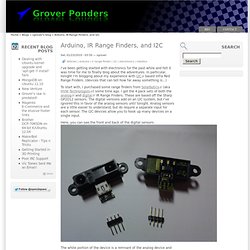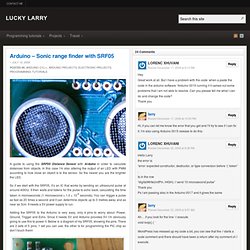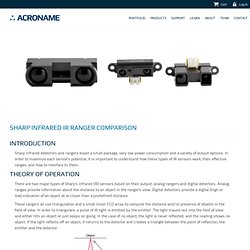

Ultrasonic Range Finder with Arduino « « DanielAndrade.net DanielAndrade.net. Arduino, IR Range Finders, and I2C. I've been getting started with electronics for the past while and felt it was time for me to finally blog about the adventures.

In particular, tonight I'm blogging about my experience with I2C based Infra Red Range Finders. (devices that can tell how far away something is...) To start with, I purchased some range finders from Solarbotics (aka HVW Technologies) some time ago. I got the 4 pack sets of both the analog and digital IR Range Finders. These are based off the Sharp GP2D12 sensors. Here, you can see the front and back of the digital sensors. The white portion of the device is a remnant of the analog device and is where Power, Ground, and the Signal line are. And here they are with the header pins soldered on. Because I2C allows many devices on one input line, we need a way to talk to particular devices.
Next we need to hook up the sensors and then write some code to make use of them. That picture has both sensors running and reporting the distance to the nearest object. 01. 09. Arduino – Sonic range finder with SRF05 Lucky Larry. A guide to using the SRF05 Distance Sensor with Arduino in order to calculate distances from objects.

In this case I’m also altering the output of an LED with PWM according to how close an object is to the sensor. So the nearer you are the brighter the LED. So if we start with the SRF05, it’s an IC that works by sending an ultrasound pulse at around 40Khz. It then waits and listens for the pulse to echo back, calculating the time taken in microseconds (1 microsecond = 1.0 × 10-6 seconds). You can trigger a pulse as fast as 20 times a second and it can determine objects up to 3 metres away and as near as 3cm. Adding the SRF05 to the Arduino is very easy, only 4 pins to worry about. SRF05 Arduino Components 220 Ohm resistor (Red, Red, Brown, Gold) SRF05 Ultrasonic range finder LED Arduino Deumilanove w/ ATMEGA328 Breadboard / Prototyping board Jumper/ Connector wires Optional 9V DC power supply or use the USB power for the Arduino Arduino SRF05 Circuit SRF05 Arduino Distance Sensor sketch.
Sharp IR Rangers Information. Introduction Sharp infrared detectors and rangers boast a small package, very low power consumption and a variety of output options.

In order to maximize each sensor's potential, it is important to understand how these types of IR sensors work, their effective ranges, and how to interface to them. Theory of Operation There are two major types of Sharp's infrared (IR) sensors based on their output: analog rangers and digital detectors. Analog ranges provide information about the distance to an object in the ranger's view. These rangers all use triangulation and a small linear CCD array to compute the distance and/or presence of objects in the field of view. Sharp IR detector angle of reflection arrival for near and far object The incident angle of the reflected light varies based on the distance to the object.
Which Detector to Use? Comparison Chart for Sharp IR Rangers Sharp IR Range Comparison Mechanical Dimensions All of the Sharp IR rangers are approximately the same size except the 0A710.